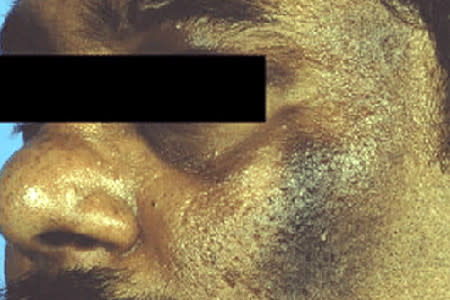Acanthosis nigricans: Tips for managing
Dermatologists offer these tips to their patients who have acanthosis nigricans (AN):
Maintain a healthy weight. Obesity is the most common cause of AN in adults and children. Studies have found that people’s skin often clears completely with significant weight loss. You can find out what your healthy weight is by calculating your body mass index.
Before using a bleaching cream, exfoliant, or other skin care product to fade the dark color, ask a dermatologist if you should use it. These products rarely fade AN and can irritate your skin, making AN worse.
Find out if you have a medical condition that is causing AN. Diabetes and other medical conditions can cause AN. Doing things that improve the medical condition often help to clear the skin.
Find out if a medicine you take is causing AN. Some medicines can cause AN. Be sure to tell your dermatologist about all the medicines you take. If medicine is causing your AN, you may be able to switch to another medicine.
If you suddenly see many dark, velvety patches on your skin, immediately make an appointment to see your dermatologist or primary care doctor. This can be a sign of cancer.
Obese man with acanthosis nigricans on his face
Studies show that many obese people see the dark patches on their skin clear when they lose a significant amount of weight.

More resources
Image
References
Kapoor S. “Diagnosis and treatment of acanthosis nigricans.” Skinmed. 2010 May-Jun;8(3):161-4; quiz 165.
Sinha S, Schwartz RA. “Juvenile acanthosis nigricans.” J Am Acad Dermatol. 2007;57:502-8.
Yosipovitch G, DeVore A, Dawn A. “Obesity and the skin: Skin physiology and skin manifestations of obesity.” J Am Acad Dermatol. 2007;56:901-16.
 Think sun protection during Skin Cancer Awareness Month
Think sun protection during Skin Cancer Awareness Month
 How to care for your skin if you have lupus
How to care for your skin if you have lupus
 Practice Safe Sun
Practice Safe Sun
 Sunscreen FAQs
Sunscreen FAQs
 Fade dark spots
Fade dark spots
 Hidradenitis suppurativa
Hidradenitis suppurativa
 Laser hair removal
Laser hair removal
 Scar treatment
Scar treatment
 Botox
Botox
 Kids' camp - Camp Discovery
Kids' camp - Camp Discovery
 Dermatologist-approved lesson plans, activities you can use
Dermatologist-approved lesson plans, activities you can use
 Find a Dermatologist
Find a Dermatologist
 Why choose a board-certified dermatologist?
Why choose a board-certified dermatologist?